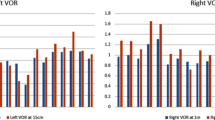Abstract
Eye-head coordination during saccadic gaze shifts normally relies on vestibular information. A vestibulo-saccadic reflex (VSR) is thought to reduce the eye-in-head saccade to account for current head movement, and the vestibulo-ocular reflex (VOR) stabilizes postsaccadic gaze while the head movement is still going on. Acute bilateral loss of vestibular function is known to cause overshoot of gaze saccades and postsaccadic instability. We asked how patients suffering from chronic vestibular loss adapt to this situation. Eye and head movements were recorded from six patients and six normal control subjects. Subjects tracked a random sequence of horizontal target steps, with their heads (1) fixed in primary position, (2) free to move, or (3) preadjusted to different head-to-target offsets (to provoke head movements of different amplitudes). Patients made later and smaller head movements than normals and accepted correspondingly larger eye eccentricities. Targeting accuracy, in terms of the mean of the signed gaze error, was better in patients than in normals. However, unlike in normals, the errors of patients exhibited a large scatter and included many overshoots. These overshoots cannot be attributed to the loss of VSR because they also occurred when the head was not moving and were diminished when large head movements were provoked. Patients’ postsaccadic stability was, on average, almost as good as that of normals, but the individual responses again showed a large scatter. Also, there were many cases of inappropriate postsaccadic slow eye movements, e.g., in the absence of concurrent head movements, and correction saccades, e.g., although gaze was already on target. Performance in patients was affected only marginally when large head movements were provoked. Except for the larger lag of the head upon the eye, the temporal coupling of eye and head movements in patients was similar to that in normals. Our findings show that patients with chronic vestibular loss regain the ability to make functionally appropriate gaze saccades. We assume, in line with previous work, three main compensatory mechanisms: a head movement efference copy, an active cervico-ocular reflex (COR), and a preprogrammed backsliding of the eyes. However, the large trial-to-trial variability of targeting accuracy and postsaccadic stability indicates that the saccadic gaze system of patients does not regain the high precision that is observed in normals and which appears to require a vestibular head-in-space signal. Moreover, this variability also permeates their gaze performance in the absence of head movements.
Similar content being viewed by others
Author information
Authors and Affiliations
Additional information
Received: 23 October 1997 / Accepted: 1 June 1998
Rights and permissions
About this article
Cite this article
Maurer, C., Mergner, T., Becker, W. et al. Eye-head coordination in labyrinthine-defective humans. Exp Brain Res 122, 260–274 (1998). https://doi.org/10.1007/s002210050514
Issue Date:
DOI: https://doi.org/10.1007/s002210050514




